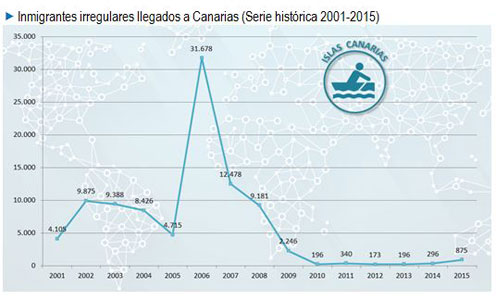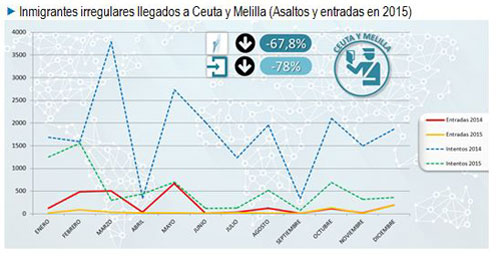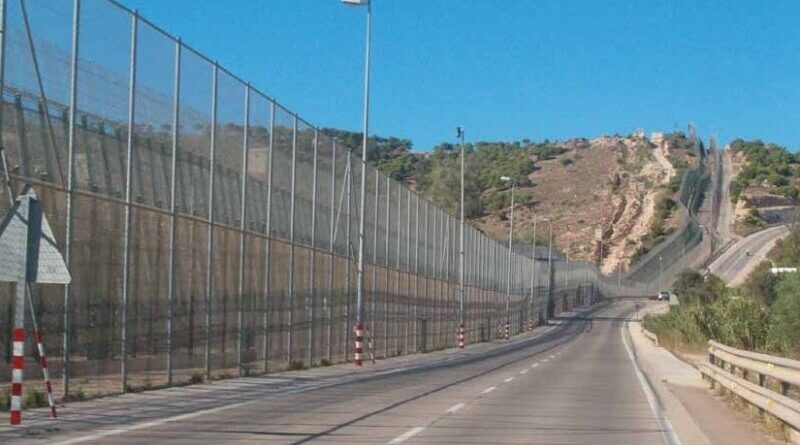Spain: Rise In Illegal Immigrants Continued In 2015, Up 16.7% From 2014
The trend for arrivals of illegal immigrants in Spain by sea posted in 2015 was similar to that for 2014, with a slight upturn in the Canary Islands, according to the Spanish government, despite a double digit increase last year from the previous year.
According to the Spanish government, 5,312 illegal immigrants arrived on Spanish coasts by sea in 2015 compared with 4,552 in 2014, an increase of 16.7%, in other words, 760 more than in the previous year.
Strong migratory pressure towards Spain seen in recent years in addition to the rising flow of refugees from Syria has led to an increase in illegal immigrants in 2015, particularly through the land borders of Ceuta and Melilla. In 2011, 5,443 illegal immigrants arrived (up 49.8%), 3,804 in 2012 (down 30%), 3,237 in 2013 (down 15%) and 4,552 in 2014 (up 40.6%).
However, the number of illegal immigrants arriving in Spain by sea is significantly lower than the 157,220 posted in the Central Mediterranean, the 880,820 posted in the Eastern Mediterranean and the 763,958 posted along the Balkan route, according to data from the European agency FRONTEX.
Despite the increase posted in 2015, the immigration management model implemented by the Ministry of Home Affairs is the main factor in the maintenance of the general trend of the global figures on the flows of illegal immigration from Africa.
The results obtained in recent years are based on a joint work ethic of efficiency and commitment, with noteworthy actions in regard to: The daily task of the National Police and the Guardia Civil; The responses from the Ministry for Home Affairs adapted to the new challenges of the immigration networks; and te consolidated collaboration between Spain and the main countries of origin and transit of illegal immigration.
A total of 4,437 illegal immigrants reached the mainland or the Balearic Islands in 2015, compared with 4,256 in 2014. This is a rise of 187 on the previous years, a slight increase of 4.3%.
The downward trend is particularly significant in the period 2006-2015. While 7,502 illegal immigrants reached the mainland or Balearic Islands in 2006, only 4,437 arrived in 2015, a 40.8% decline. In the case of the Canary Islands, this figure has plummeted from 31,678 illegal immigrants in 2006 to only 875 in 2015, a decline of 97.2%.
However, and despite the good results seen in the fight against illegal immigration in the Canary Islands over recent years, 2015 closed with the arrival of 875 immigrants, 579 more than in 2014, when only 296 illegal immigrants reached the shores of the islands.
 The Spanish government said that it should be pointed out that this increase does not alter the downward trend being seen year after year in the fight against illegal immigration in the Canary Islands, as can be patently seen in the historical series from 2001 to 2015 (see chart).
The Spanish government said that it should be pointed out that this increase does not alter the downward trend being seen year after year in the fight against illegal immigration in the Canary Islands, as can be patently seen in the historical series from 2001 to 2015 (see chart).
Ceuta and Melilla posted a year-on-year rise of illegal immigrants trying to gain access to the two autonomous cities in 2015, either by swimming to their shores, hidden in vehicles or other means of transport, or by breaching the border perimeter.
Specifically, a total of 11,624 illegal immigrants reached Ceuta or Melilla in 2015, a rise of 55.3%, or 4,139, on 2014, when 7,485 gained access.
In 2015, attempts to breach the border perimeter to Ceuta and Melilla fell by 67.8% and arrivals in the two cities by this means fell by 78%, thanks to the dissuasive methods employed by the State law enforcement agencies.
 The Spanish government said that it should be pointed out that of the 7,485 illegal immigrants to arrive in Ceuta or Melilla in 2014, 3,305 were from Syria and 4.180 from other countries. This figure rose in 2015 with the arrival of 11.624 illegal immigrants, of which 7,189 were potential refugees from Syria while 4,435 were of other nationalities.
The Spanish government said that it should be pointed out that of the 7,485 illegal immigrants to arrive in Ceuta or Melilla in 2014, 3,305 were from Syria and 4.180 from other countries. This figure rose in 2015 with the arrival of 11.624 illegal immigrants, of which 7,189 were potential refugees from Syria while 4,435 were of other nationalities.
In this regard, 7,164 refugees reached Melilla from Syria in 2015, 78.1% of the total, compared with 3,072 in 2014, 52.8% of the total. This is a rise of 133.2%, or 4,092 refugees more than in the previous year.
The International Protection Offices inaugurated by the Minister for Home Affairs, Jorge Fernández Díaz, in 2015, at the border posts in Ceuta and Melilla to help cope with the already existing number of claims for asylum, have allowed the arrival of this number of Syrian refugees at the border with Ceuta, and particularly Melilla, to be handled more efficiently.
In 2015, the Ministry for Home Affairs repatriated a total of 20,091 illegal immigrants, down by 4.3% (902 fewer) on the total of 20,993 in 2014, the fourth straight year of declines.

